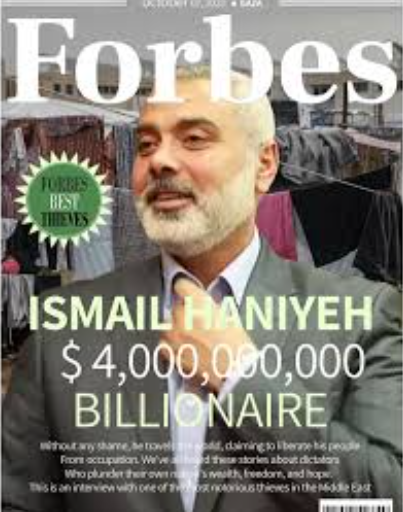Virendra Pandit
New Delhi: Amid the ongoing war between Hamas and Israel, while many amongst the 2.3 million poor Palestinians struggle to get a morsel of food and a bottle of water, leaders of the ruling terror outfit have amassed huge wealth. Many of them are war merchants, living in comfort in Qatar, their financier.
While Palestinians in the Gaza Strip scramble for essential needs, the top leadership of Hamas is reportedly living comfortably a life in opulence.
The top three Hamas leaders, according to the media reports, have amassed wealth of USD 11 billion, which came from various sources, including Qatar, which has been allegedly supporting them financially to control Gaza. These leaders–Ismail Haniyeh, Moussa Abu Marzuk, and Khaleed Mashal– have been keeping their luxury lifestyle in Qatar, a relatively small yet powerful emirate in the Middle East, which provided a haven for them.
These leaders were seen frequenting diplomatic clubs and traveling on private jets. The Israel embassy in the US also shared a post on X (formerly Twitter) giving a breakup of how much each of the top three leaders is worth.
Haniyeh and Mashal are claimed to be worth USD 4 billion each while Marzuk is worth USD 3 billion. Their outfit, Hamas’ annual turnover is USD 1 billion.
Interestingly, the media reported that these Hamas leaders had little desire to govern Gaza. Instead, they wanted the war against Israel to become a permanent feature.
“I hope that the state of war with Israel will become permanent on all the borders and that the Arab world will stand with us,” Hamas’ media advisor Taher El-Nounou was quoted as saying, adding that its goal is “not to run Gaza and to bring it water and electricity and such.”
To continue this war, Hamas has stockpiled fuel, food, and medicine, as well as ammunition and weapons, in the miles of tunnels it has carved out under Gaza. As supplies of virtually every basic human necessity dwindle in the Gaza Strip, one group in the besieged enclave remains well-stocked—Hamas.
Arab and Western officials admitted to Israeli claims of Hamas having amassed stores of virtually everything needed for a drawn-out fight.
Hamas has reportedly stockpiled a million gallons of fuel for vehicles and rockets; caches of ammunition, explosives, and materials to make more; and stockpiles of food, water, and medicine, the officials said. A senior Lebanese official said Hamas operatives, numbering up to 40,000, had enough stocked away to keep fighting for three to four months without resupply.
One of the four Israeli hostages released by Hamas even described the outfit providing captives with medicine, shampoo, and feminine hygiene products.
While the Israeli blockade has left Gaza’s 2.3 million people scraping by with what little food and water they scrounge up, it does not yet appear to have begun to degrade Hamas’s ability to fight. Yet with Gazans facing a humanitarian catastrophe, Hamas’s stockpiles raise questions about what responsibility, if any, it has to the civilian population.
Yocheved Lifshitz, 85, a freed hostage, said that while in captivity she ate the same single meal that Hamas fighters eat every day: pita bread with two kinds of cheese and cucumber. There was little chance that Hamas would be willing to provide food or any other kind of supplies to aid civilians. “The Hamas movement cares only about the Hamas movement,” he said. “The public of Gaza means absolutely nothing to Hamas.”
Hamas has grown adept at manufacturing its weapons in underground bunkers and shielding them from Israel’s advanced surveillance systems. So the smuggling routes that Hamas once relied on, through an intricate network of tunnels to Egypt, have become less relevant. Hamas has also raised money by taxing the Palestinian population that lives in Gaza, making outside support less relevant than before.

